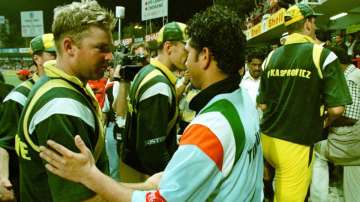On this day, 22 years ago, Sachin Tendulkar had carved out a sensational and a sublime 134 off 131 as India successfully chased down 273 to win by six wickets. It was his second century in two days, the other one dubbed as the 'Desert Storm', as Sachin wrapped up a memorable week at Sharjah with 357 in 334 balls at an average of 119 (at a strike rate of 107). Eight months later, Sachin had pocketed a record-scripting 1894 runs at a blistering average of 65.31 in that year with nine centuries - a record that still stands tall in one-day international cricket with Sourav Ganguly coming closet to the tally, the very next year (1767 runs at 46.50). And the record tally came despite his struggle at the start of the calendar year that left him without a century for as many as 33 innings before he broke the shackles with his 143 in 131. India had lost that match, but Sachin's valiant efforts helped them sneak past New Zealand in the tri-series points table. And his birthday special helped India win the trophy.
Sachin has played far better innings under tougher conditions, before and after that 1998 Sharjah tournament, but that birthday week 22 years back has its own significance in Indian cricket with Sachin playing the role as a protagonist in the team's rise as an ODI powerhouse.
Sachin had begun his ODI career in late 1989 as a middle-order batsman for an Indian side that lost more than they won in the format. In 69 matches played between Sachin's debut and 1993, India had a win percentage of only 44.93 (31 out 69). And the youngster managed 1679 runs in 62 innings at 31.09 and 74.32 as strike rate, with 12 half-centuries. He was although marginally, of what an average middle-order batsman of that period managed.
In 1994, then coach Ajit Wadekar and captain Mohammad Azharuddin decided to move Sachin up the batting lineup and play him as an opener, a move that made wonders not just for the cricketer but also for the team. And it was clearly evident from his numbers.
He scored his first half-century in his third innings as an opener, added three more to his tally before scoring his maiden ODI century, a sensational 110 in Colombo against Australia, in September. He scored two more by the end of the calendar year and ended 1994 with 1089 runs at 47.3, his first 1000-plus calendar year in ODI history. Sachin emulated the feat five more times in the second part of his career, the one that has exceptionally stood out in his glorious 23-year-long career. It only missed that cherry on the top, a World Cup trophy.
Sachin's career compared to aggregate numbers at that batting position
| Phase |
Innings |
Runs |
Average |
Strike rate |
Aggregate average |
Aggregate strike rate |
| Debut-1993 |
62 |
1679 |
31.09 |
74.32 |
26.99 |
72.34 |
| 1994-2003 |
250 |
11006 |
48.48 |
88.87 |
33.07 |
72.84 |
| 2003-Retirement |
140 |
5741 |
44.16 |
85.36 |
32.29 |
78.22 |
He scored 11006 runs in 250 ODI innings during these 10 years at 48.48 and a strike rate of 88.87. Compared to the aggregate average of openers during that period, the numbers stood 33.07 and 72.84 respectively. Moreover, according to ESPNCricinfo, he was also ahead of the batters he batted with during that period as the average at the other end of the crease stood 31.4 and strike rate as 81. He was the highest run-getter during that period and his average was the second-best after Michael Bevan's among batters with more than 5000 runs.
After the World Cup year, the Ganguly era slowly began to fade away, while Sachin incurred a lot many injuries, including that tennis elbow. He continued to play a significant role in the team, but his scoring was less compared to the batsman at the other end. He crossed the 1000-run mark only once in a calendar year, in 2007, when he amassed 1425 runs at 47.5.
14 years after that sensational birthday week in Sharjah, Sachin bid adieu to the format, a year before his international retirement, but India had by then become an ODI powerhouse. And he even managed to eventually add that cherry on the top, a World Cup win in 2011.

